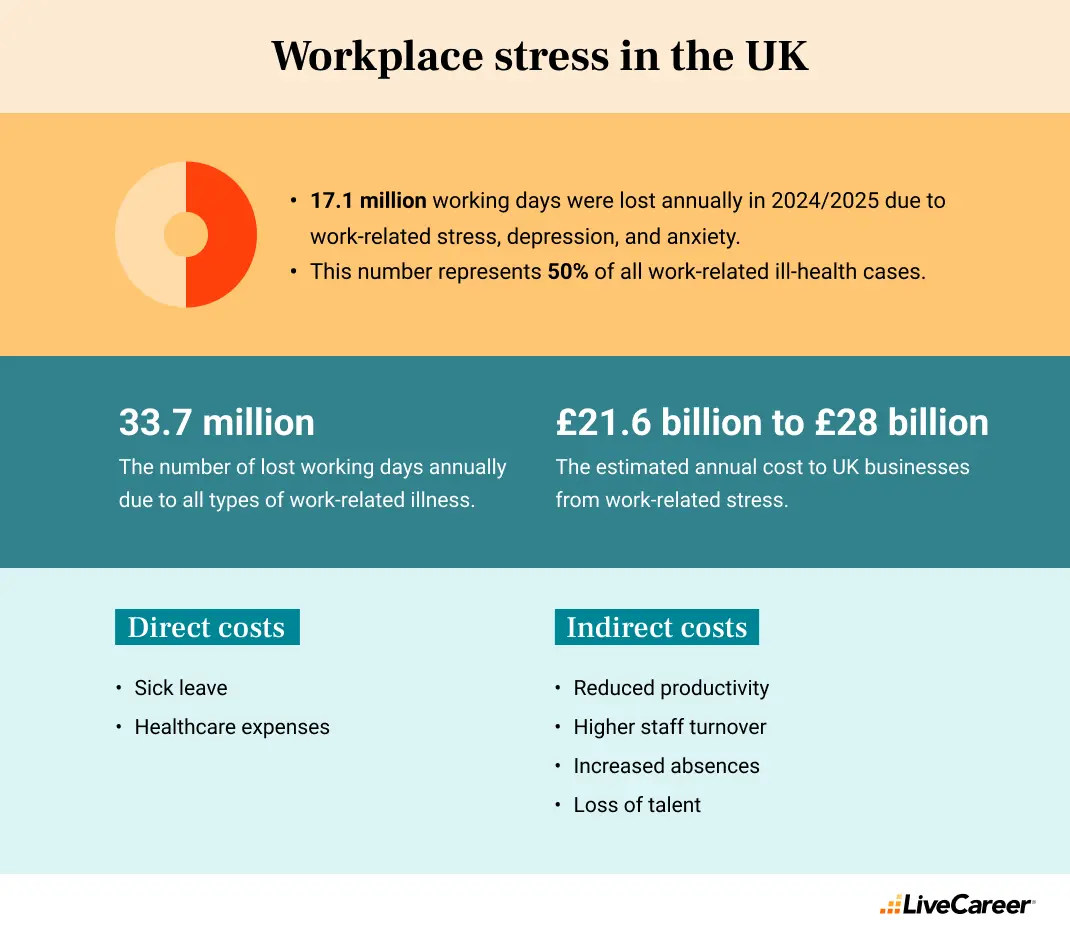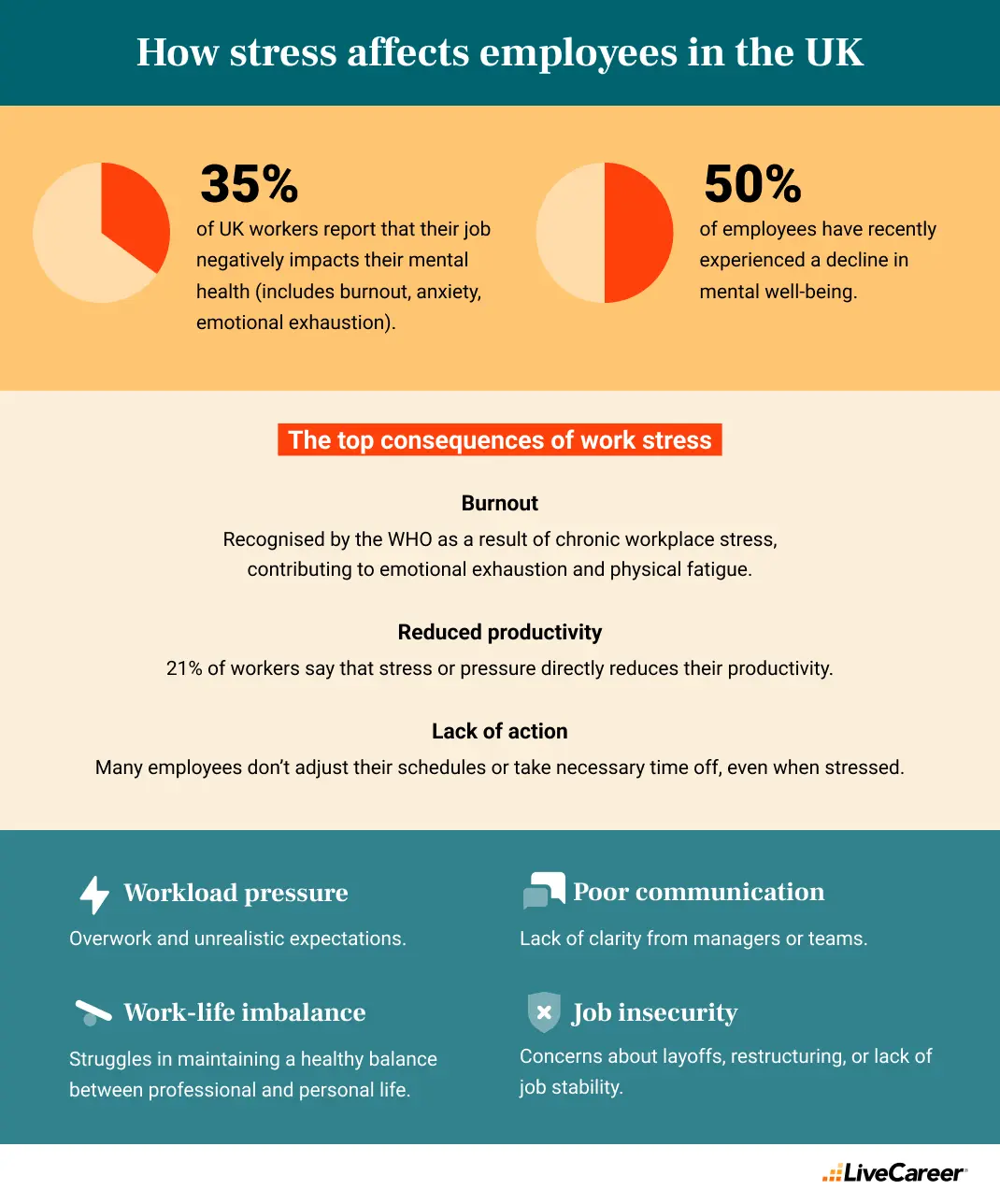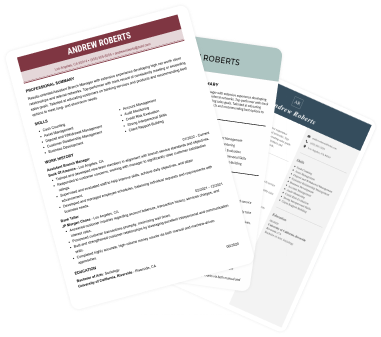
How to Write a CV: Example & Tips
Learn how to write a CV in a few steps. Make a good CV for the UK job market following a dedicated CV template, expert tips, and examples.
November 13, 2025
Last updated on 7 November, 2025

Workplace stress has become a daily reality in the UK, regardless of industry or job type. Research shows that it affects almost 8 in 10 workers, impacting mental health, productivity, and even the economy.
In this article, I’ll explain who is most affected by workplace stress, how often work negatively impacts mental health, and how to address these issues.
According to the Health and Safety Executive’s 2024 report, work-related stress, depression, and anxiety account for approximately 17.1 million lost working days annually in 2024–2025, representing almost half of all work-related ill health cases. The broader category of work-related ill health results in approximately 33.7 million working days being lost each year.
From an economic perspective, work-related stresscosts UK businesses between £21.6billion and £28 billion annually. This estimate encompasses direct costs, such as sick leave and healthcare, as well as indirect impacts, including reduced productivity and staff turnover.

Although stress at work is a common issue, it does not affect everyone in the same way. When it comes to UK workers, the most affected group includes those aged 35–54, with women in this age group reporting particularly high levels of stress that they experience daily.
This statistic is directly linked to various pressures, such as financial worries and the balancing of family or relationship challenges alongside their careers. Younger workers (age 18 to 34) often experience stress related to job performance and early career concerns, while older workers (over 65) report stress primarily associated with health issues rather than work itself. Interestingly, the burnout rates are significantly higher in the younger group, with many workers requiring frequent time off from work.
Notably, 91% of UK adults reported high or extreme stress levels in the past year, with younger adults (18–24) indicating early burnout and requiring more time off work. Frontline managers and workers in areas such as professional services, healthcare, education, and financial sectors experience particularly high stress, with some industries reporting a 40% greater likelihood of chronic stress symptoms due to high job demands.
Approximately 35% of UK workers say their job negatively impacts their mental health, facing burnout, anxiety, emotional exhaustion, and feelings of overwhelm. Nearly half have experienced a recent decline in mental well-being.
Burnout, officially recognised by the WHO as a result of chronic unmanaged workplace stress, is a common issue. 21% of workers admit that high stress or pressure has reduced their productivity, yet many do not adjust their work schedules or take time off. Workload pressure, lack of communication, struggles with work-life balance, and job insecurity remain the primary stressors.

Around 11% of UK workers took time off due to mental health issues related to work in the previous year, rising to about 20% overall for stress-related absences. Younger workers (18–24) are the most likely to require time off, with nearly 3 in 10 in this group taking leave, often intensified by broader health challenges and NHS wait times.
However, workers are still hesitant about disclosing their stress to managers, with 19% of employeeschoosing not to reveal it to avoid judgment or negative consequences.
Despite 81% of UK workplaces increasing focus on mental health since the pandemic, around one-third of employees still think that the support they receive is inadequate. Many feel uncomfortable contacting mental health services due to judgments or a lack of trust. Managers often feel unprepared to have sensitive mental health conversations, which hinders effective intervention. Only about 32% of workplaces have formal plans to identify signs of chronic stress and prevent burnout, emphasising the need for comprehensive mental health policies and supportive workplace cultures. This could improve productivity and retention.
Workplace stress remains a key concern in the UK, affecting various groups of workers, including women, mid-career adults, young workers, and frontline managers. The consequences, such as burnout, mental health problems, and absence, result in serious human and economic costs on a yearly scale. While we can see progress in how employers support their workers, significant gaps remain in policy and culture. UK employers must implement clear strategies and create open environments where mental health concerns can be discussed openly and without guilt.
Here’s how employers can strengthen mental health in the workplace:
Thank you for reading this guide on mental health at work in the UK and tackling work-related stress. I hope it does not affect you directly, but if it does, I trust the information here has offered you some useful ideas for managing and overcoming stress in the workplace.
The findings and insights presented in this article are based on a review of the most recent and authoritative data on workplace stress and mental health in the UK. To ensure accuracy and relevance, information was gathered from multiple sources, including government reports, independent research organisations, and workplace surveys.
The analysis draws primarily on national-level statistics, supplemented by sector-specific and demographic breakdowns (age, gender, and job type). Where possible, findings from different reports were cross-checked for consistency and reliability.
Our editorial team has reviewed this article for compliance with LiveCareer’s editorial guidelines. It’s to ensure that our expert advice and recommendations are consistent across all our career guides and align with current CV and cover letter writing standards and trends. We’re trusted by over 10 million job seekers, supporting them on their way to finding their dream job. Each article is preceded by research and scrutiny to ensure our content responds to current market trends and demand.
Category: Career Advice
Crafting a job-winning CV is all about showcasing your unique skills and experiences. Start with a strong personal statement that highlights your career goals and achievements.
Try Our CV Builder Now